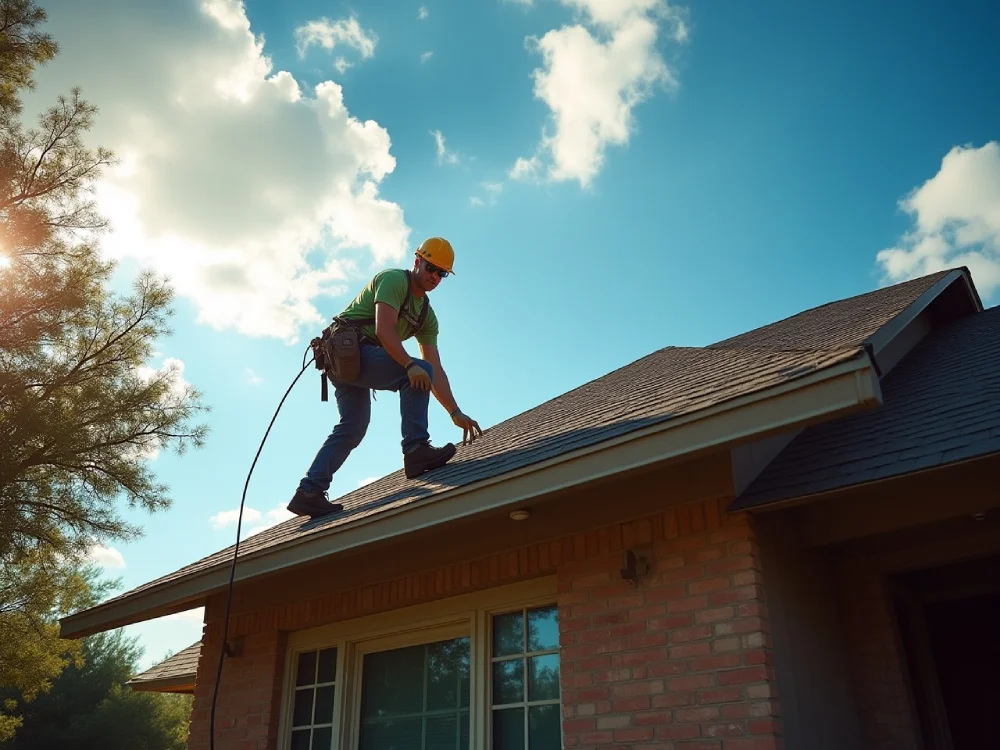
Professional roof inspections every 12-18 months, combined with prompt repairs and proper maintenance, can double a typical Texas roof's lifespan from 15 years to 30 years by catching problems before extreme weather causes expensive damage.
Texas roofing professionals confirm that scheduling professional inspections every 12-18 months transforms a standard 15-year asphalt shingle replacement into a 30-year investment. This proactive approach catches minor issues before extreme UV radiation, temperature swings, and hailstorms cause expensive damage. Combined with prompt repairs, proper gutter maintenance, and seasonal preventive care, homeowners save thousands while protecting their property. The complete maintenance strategy reveals surprising ways to optimize roof performance.
Three pivotal factors determine whether a roof lasts its full expected lifespan or fails prematurely: the frequency of professional inspections, the speed of problem detection, and the consistency of preventive maintenance.
Professional inspectors identify hidden damage before moisture compromises structural integrity, while their trained eyes spot issues homeowners typically miss. According to the National Roofing Contractors Association, these evaluations reveal enhanced ventilation benefits through proper airflow assessment, preventing heat buildup that deteriorates materials.
Professional Inspection Benefits:
Spring and fall represent ideal inspection timing, allowing professionals to assess how the roof weathered extreme seasonal conditions. Industry experts recommend scheduling assessments every 12-18 months, though severe weather demands more frequent checks.
While professional inspections maximize roof longevity through early problem detection, Texas homeowners face environmental conditions that fundamentally challenge even the most diligent maintenance efforts. The state's extreme UV radiation creates unrelenting assault on roofing materials, breaking down chemical bonds and accelerating deterioration rates beyond normal expectations.
Combined with scorching temperatures reaching triple digits, roofs experience thermal degradation patterns that cause continuous expansion and contraction cycles, weakening structural integrity with each passing season. Texas experiences some of the most extreme weather conditions in the United States, including:
Texas Weather Challenges:
These harsh conditions transform a typical 30-year roof into one lasting merely 15-20 years. Common signs of deterioration include blistering and warping that appear on asphalt shingles after prolonged heat exposure.
The actual performance of roofing materials under Texas conditions reveals dramatic differences in longevity that every homeowner needs to understand before making investment decisions. Different roofing materials perform vastly differently in extreme climates like Texas.
| Roofing Material | Expected Lifespan | Texas Performance | Best Use Cases |
| Asphalt Shingles | 15-30 years | 15-20 years | Budget-conscious homes |
| Metal Roofing | 40-70 years | 50+ years | Energy efficiency priority |
| Clay/Concrete Tiles | 50-100 years | 75+ years | Spanish/Mediterranean styles |
| Slate | 75-100+ years | 100+ years | Premium luxury homes |
| Wood Shake | 20-30 years | 15-25 years | Rustic/traditional designs |
| Flat/Commercial | 15-30 years | 10-25 years | Commercial buildings |
Clay and concrete tiles achieve 50-100 year lifespans, demonstrating exceptional resilience across geographic variability from humid Houston to arid El Paso. Premium slate materials last 75-100+ years, representing lifetime investments that justify their higher upfront costs.
Proper roof maintenance requires three fundamental practices that experienced Texas contractors consistently emphasize for maximum longevity. The Asphalt Roofing Manufacturers Association confirms that consistent maintenance can extend roof life by 50% or more.
Regularly cleaning gutters stands as one of the most critical yet overlooked aspects of roof maintenance that Texas homeowners can perform. Proper drainage safeguards roofing materials from water damage that causes premature deterioration and costly repairs.
Professional Gutter Maintenance Schedule:
Clean gutters prevent water pooling that destroys shingles, causes mold growth, and damages fascia boards. This simple maintenance extends roof lifespan by 5-10 years, protecting investments in quality materials.
Swift moss removal protects Texas roofs from accelerated deterioration that costs homeowners thousands in premature replacements. The impact of moss presence extends beyond appearance, as retained moisture penetrates roofing materials, compromising structural integrity.
Safe Moss Removal Process:
Professional moss removal strategies prevent drainage blockages while eliminating spores that trigger allergies. Regular maintenance stops water infiltration that damages ceilings, walls, and belongings.
When minor roofing issues receive immediate attention, homeowners prevent small problems from escalating into expensive disasters. Studies show that reactive maintenance creates 78% higher annual costs compared to scheduled preventive care.
Critical Immediate Repairs:
Smart property owners document all repairs with photos and detailed reports for warranty protection. This proactive approach saves homeowners significant money annually through prevented major repairs.
A homeowner's ability to recognize critical warning signs can mean the difference between a planned roof replacement and an emergency repair costing thousands more. Professional roofers recommend immediate evaluation when multiple warning signs appear simultaneously.
Immediate Replacement Indicators:
When damage affects more than 30% of the surface area, replacement becomes more cost-effective than patching. Professional assessment helps determine whether repair or replacement offers better long-term value.
Professional installation stands as the foundation determining whether roofing materials achieve their advertised lifespan or fail decades early. Expert contractors understand that moisture intrusion prevention requires precise flashing placement around every penetration point.
Critical Installation Elements:
Studies show improper installation reduces roof lifespan by 30-50%, regardless of material quality. Certified professionals follow industry standards that prevent common failure points while maintaining warranty protection.
Texas homeowners face unique challenges from extreme heat, severe storms, and damaging hail that can destroy standard roofing materials within years. Smart material choices convert roofs from vulnerable targets into fortified shields that actively combat weather extremes.
The difference between standard roofing materials and premium designer shingles becomes crystal clear after the first major hailstorm strikes North Texas communities. Impact-resistant shingles offer superior protection through advanced engineering.
Premium Shingle Advantages:
These reinforced materials prevent thousands of insurance claims across Texas, delivering long-term value through reduced maintenance and energy savings.
Modern metal roofing systems deliver unmatched protection against extreme weather conditions that regularly impact Texas properties. Metal roofs offer superior performance in extreme climates through advanced engineering and materials science.
Metal Roofing Benefits:
Standing seam designs feature hidden fasteners that eliminate leak points while providing excellent thermal performance throughout scorching Texas summers.
Property owners often discover that the real financial impact of roof maintenance becomes clear only when comparing long-term costs against replacement expenses. Preventive maintenance programs demonstrate substantial cost advantages over reactive approaches.
| Maintenance Strategy | Annual Cost | Roof Lifespan | Total 30-Year Cost |
| Reactive repairs only | $200-500 | 15 years | $45,000+ |
| Basic maintenance | $300-600 | 20 years | $35,000 |
| Comprehensive care | $400-800 | 30 years | $25,000 |
| Premium materials + maintenance | $500-1000 | 40+ years | $20,000 |
Financial Advantages Include:
Trusted partnerships with maintenance professionals transform roofing from reactive expense to strategic investment, delivering measurable returns through extended performance and reduced replacement costs.
Texas homeowners who invest in regular professional inspections, timely maintenance, and weather-appropriate materials can effectively double their roof's lifespan from 15 to 30 years. The harsh Texas climate demands proactive care, but the financial rewards prove substantial—smart roofing decisions today save thousands in premature replacements while protecting homes from costly water damage.
Ready to maximize your roof's lifespan and protect your investment? Contact TriStar Built today for a comprehensive roof inspection and personalized maintenance plan. Our experienced team has helped North Texas homeowners extend roof performance and reduce replacement costs since 2006. We're not trying to be the cheapest—we're trying to be the best, ensuring your roof withstands Texas weather extremes while delivering maximum value for decades to come.
Because of the extreme weather Texas brings, regular roof inspections are critical. A roof in Texas should be inspected every 12–18 months, with additional checks after severe storm damage. Spring and fall are ideal times to assess your roof’s condition, spot potential issues early, and protect your home. These maintenance tips can help your roof last longer and give you peace of mind knowing your roof remains in good condition.
Roof repair services done reactively may seem cheaper upfront, but they shorten the service life of your roof. Proactive maintenance costs about $400–800 annually yet can extend the lifespan of your roof to 30 years. In contrast, reactive approaches cost $200–500 yearly but typically require a new roof installation every 15 years. Over 30 years, proactive care saves $15,000–20,000—showing how the right roofing approach can save money in the long run while ensuring the integrity of your roof.
For Texas homes, metal roofing is a smart choice for Texas because of its durability and energy efficiency. With a lifespan in Texas of 40–70 years, metal roofs provide 25–40% energy savings and stand up to storm damage better than most materials. While the upfront cost is higher, their full lifespan and reduced repairs mean the total cost of ownership is 40–50% lower compared to asphalt shingles. Using high-quality roofing materials plays a major role in prolonging the lifespan and performance of your roof.
Homeowners can safely handle simple maintenance tips every season, like gutter cleaning and checking for visible leaks from the ground. However, for roof repair, structural issues, and inspections, working with a professional roofing contractor is essential. Walking on your roof is dangerous, can cause further damage, and may void warranties. Hiring an expert roofing company ensures your roof’s condition is properly evaluated by those with the right skills, safety training, and workmanship.
If your roof is showing signs of damage that affect more than 30% of the surface, or if your roof’s condition is declining after 20+ years, a new roof may be more cost-effective than constant roof repair. Professional evaluation from a trusted roofing company will help you make informed decisions about whether a new roof installation or targeted roof repair services are the right fit. The goal is to extend your roof’s service life and ensure it continues to be your home’s first line of defense.

Whether you’re remodeling a home, expanding a business, or starting from the ground up, TriStar Built is here to guide you every step of the way. With a focus on craftsmanship, communication, and results that last, we make the construction process clear, smooth, and worth every investment.

LOCATION: 2126 James Street, Denton, TX 76205
PHONE: (940) 381-2222
© 2025 TRISTAR BUILT - ALL RIGHTS RESERVED | WEB DESIGN & SEO BY: Authority Solutions®